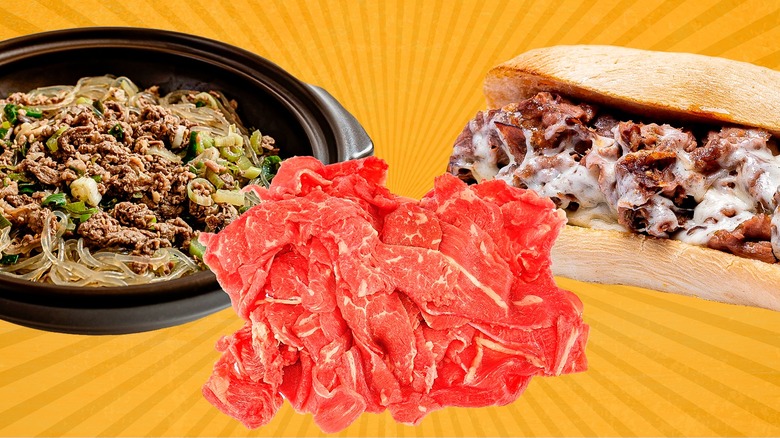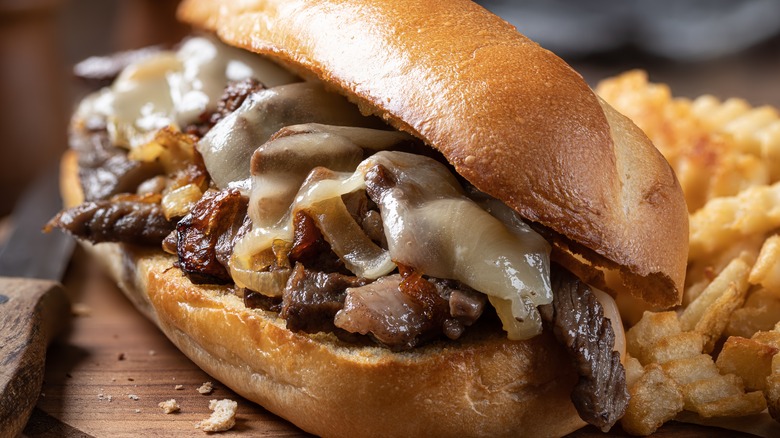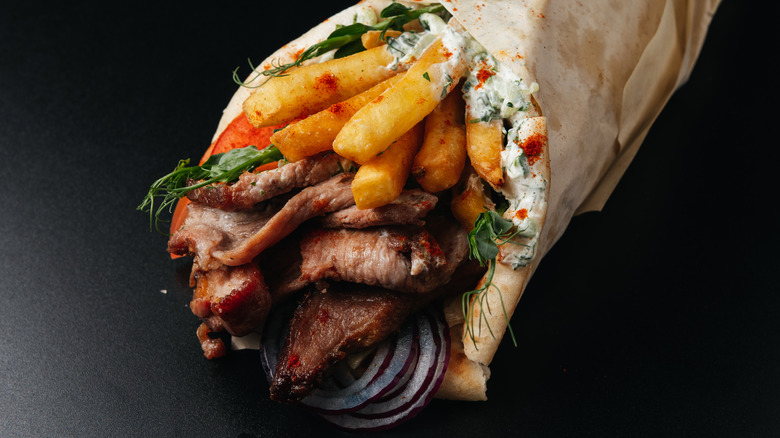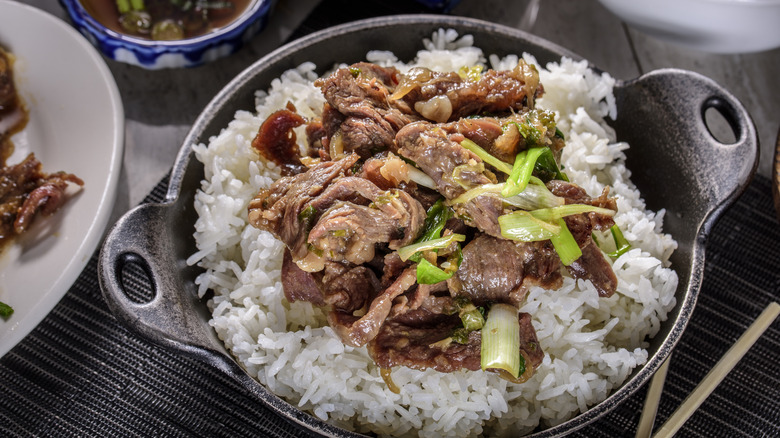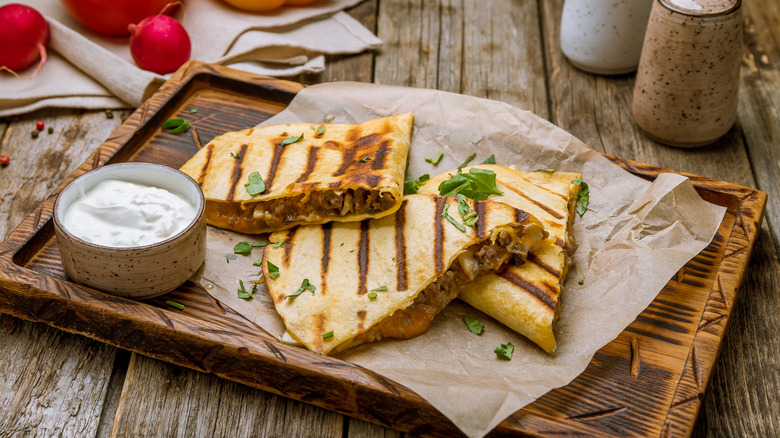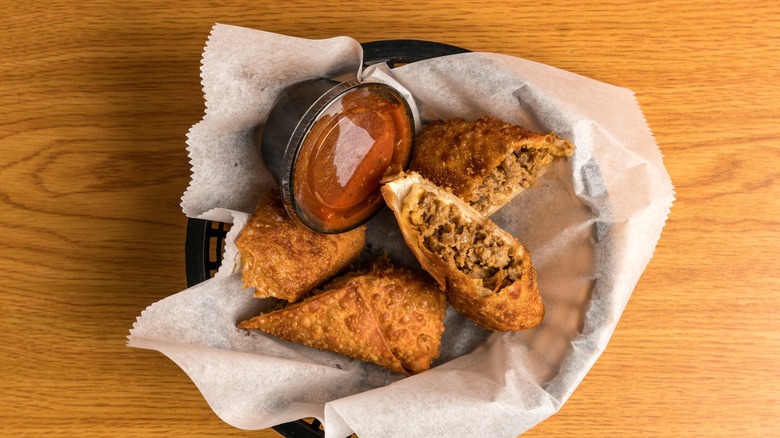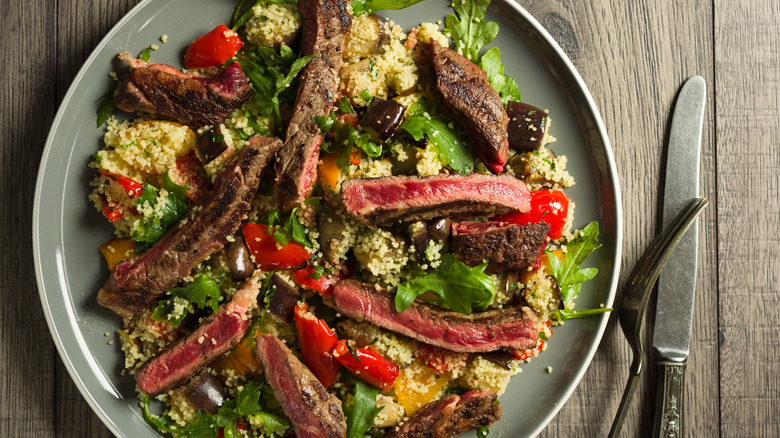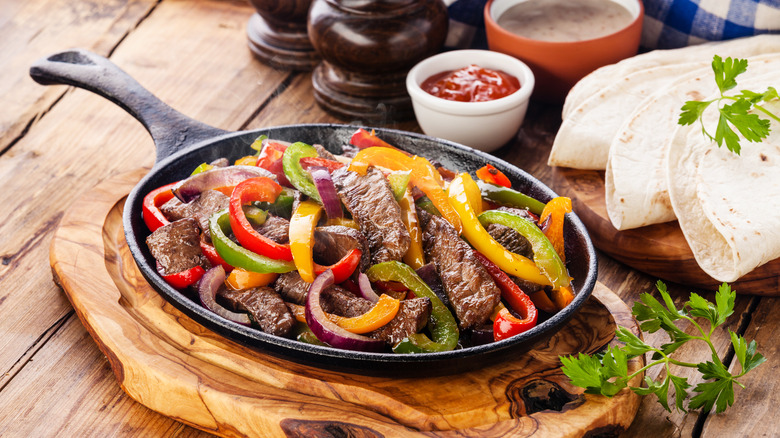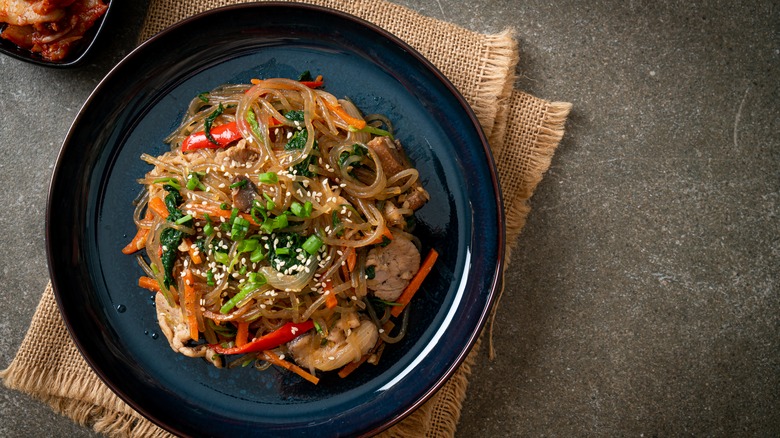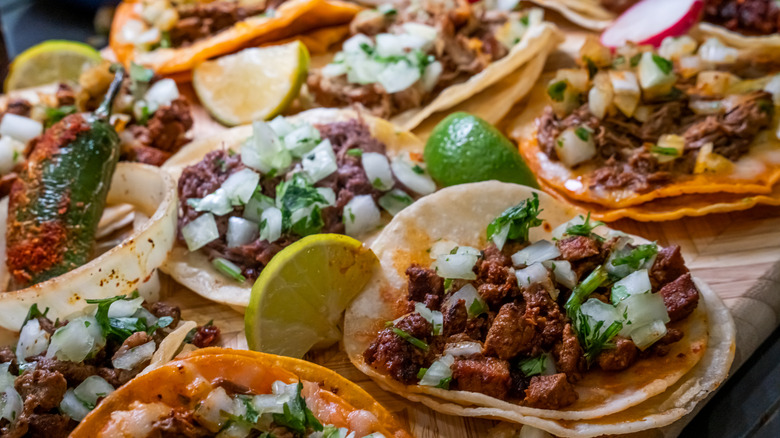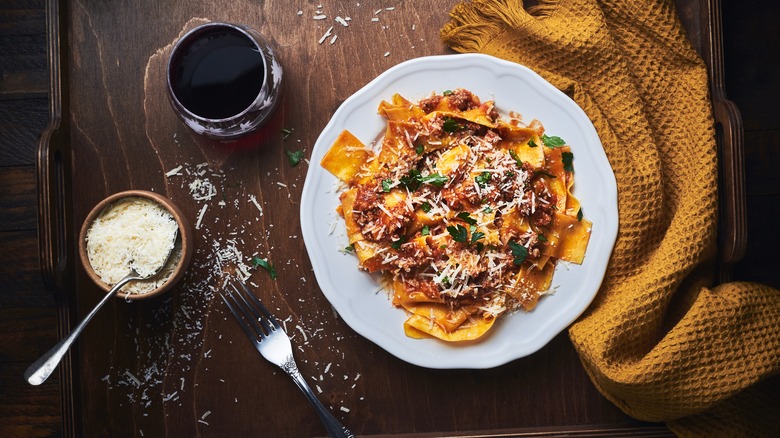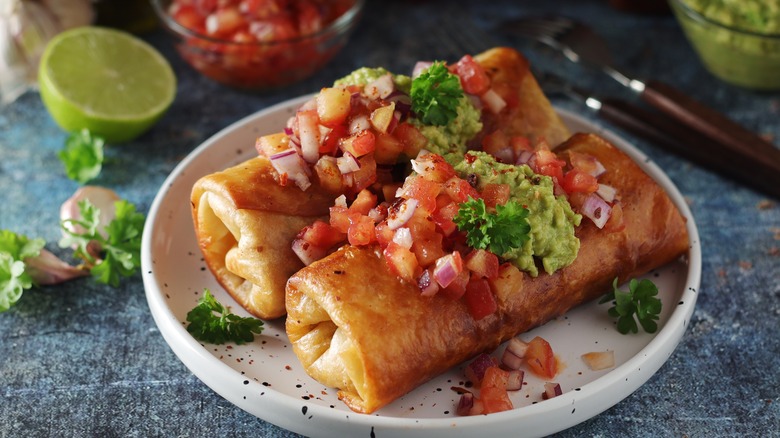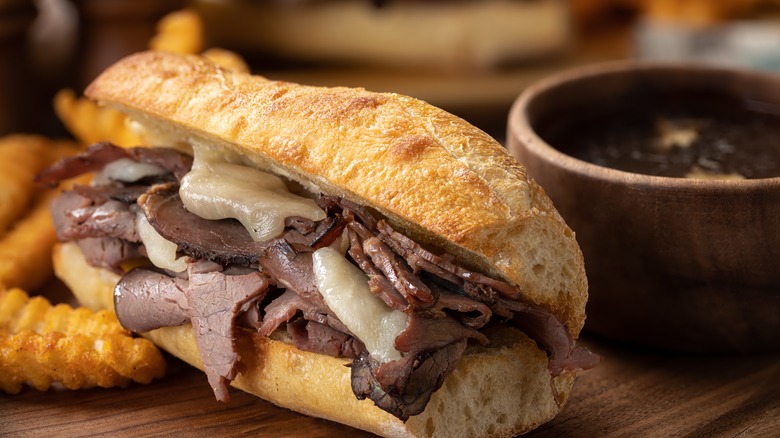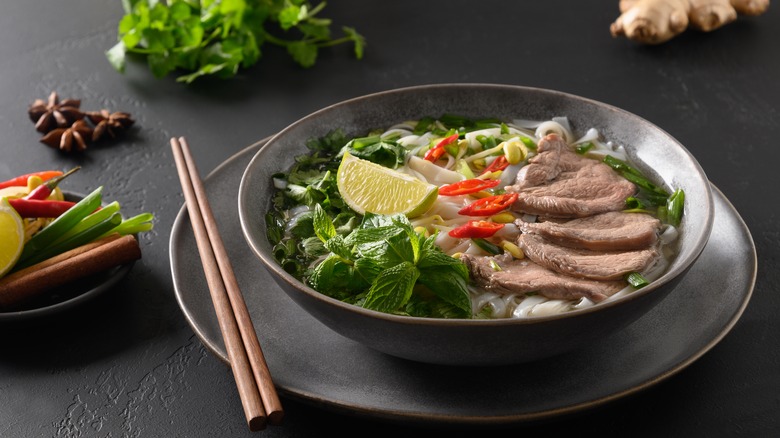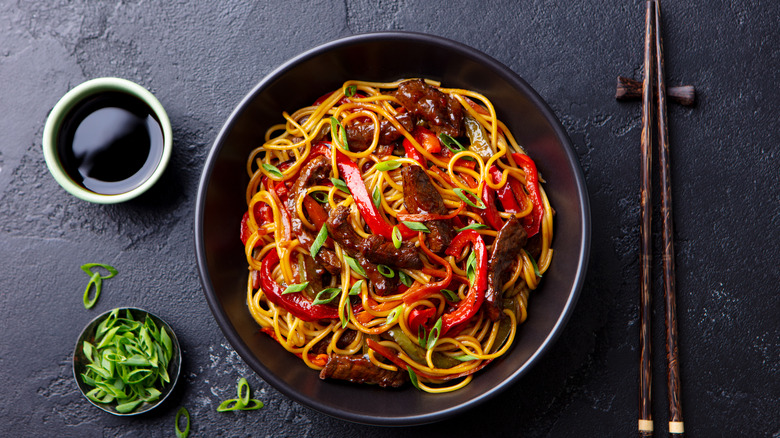15 Best Ways To Use Shaved Steak
If you're looking for a quick way to add flavor, nourishment, and convenience to your meals, look no further than shaved steak. It turns out that shaved steak is an ideal option for far more than just Philly cheesesteaks — it's delicious when added to a range of dishes and types of cuisines. Unlike a thicker cut of beef, shaved steak typically cooks in mere minutes, making it an optimal weeknight dinner option. Shaved steak stays tender and absorbs maximum flavor, making it a versatile option that can add depth to your food in minimal cooking time.
An added bonus is that when cooking shaved steak, a specific cut of beef isn't required. While ribeye is a superior option, skirt steak is an economical but still flavorful choice. You can either purchase steak pre-shaved or slice it yourself; if you go this route, briefly freeze your steak to make it easier to slice before using a well-sharpened knife. As for our suggestions, some already traditionally use shaved or thinly sliced steak, while others may not require steak or even a protein but would be enhanced by its addition.
Make homemade Philly cheesesteaks
The first on this list is an iconic shaved steak dish. The origin of the Philly cheese steak traces back to 1930s Philadelphia. Pat Olivieri, who ran a hot dog stand near a Philadelphia Italian market, is credited for the creation. The original Philly cheesesteak just included beef and onions, but since becoming a well-known dish across the country, additions such as cheese (typically provolone, American, or even cheese whiz) and even sautéed peppers or mushrooms became commonplace. Nowadays, you may even see popular variations such as the pizza cheese steak or a chicken cheese steak, but the original recipe still reigns supreme. And luckily, you don't have to travel to Philly to enjoy one.
Thinly shaved ribeye is integral to the recipe when making it at home — you'll want steak that's cut down to ⅛ inch-thick slices or just as thin as you can get them. The rest of a homemade Philly cheesesteak comes together relatively simply, with sautéed vegetables and melted cheese. The hoagie roll (another invention we can thank Philly for) pulls the sandwich together — using a fresh, toasted roll is best to get that crunchy outside and soft, warm inside.
Serve it as a gyro for a classic Greek meal
While gyros hail from Greece, this popular street food can be found in different forms throughout the world. Shawarma in the Middle East, döner kebabs in Turkey, al pastor in Mexico, and gyros all utilize meat that has been cooked on a vertical rotisserie before being cut into thin slices. Some even claim that this classic dish didn't even come to Greece until the 1920s due to refugees from Constantinople and Smyrna. In the 1960s, gyros were introduced to the United States and have since become a Greek staple. For the Greek gyro, lamb, beef, or chicken are all favorable options, which are then dressed with pickled onions, feta cheese, tomato, and tzatziki sauce (an herby yogurt-based sauce made with cucumbers and garlic) and are all tucked into pita bread.
If you're making this at home, don't worry; you can forego the vertical spit. Shaved steak marinated with oregano, garlic, and other seasonings will do the trick, and don't be afraid to improvise a bit to create a flavor profile to your taste. Serve it with fries or a salad (or both) on the side for a full and completely satisfying meal.
Throw it in the slow cooker to make Mongolian beef
For a sweet, tangy, and practically effortless weeknight dinner starring shaved steak, slow-cooker Mongolian beef is the way to go. Despite its name, Mongolian beef actually has Taiwanese-Chinese origins — it was initially created in the 1950s at a Mongolian barbecue restaurant in Taiwan. It's since become a well-liked choice at Chinese restaurants across the United States, but you can create this comforting classic at home with just a slow cooker.
An added bonus is that apart from thinly sliced flank steak, all it requires are some pantry staples that you likely already have. Cornstarch, vegetable oil, minced garlic, ginger, water, reduced-sodium soy sauce, brown sugar, and red pepper flakes come together for the sauce. The brown sugar caramelizes during the cooking process, leaving you with a thick, almost decadent end result. There's also plenty of room for creativity — if you'd like some extra heat, for instance, simply add in extra chili flakes, chili peppers, or Sriracha. Shredded carrots, green onions, and sesame seeds pull the meal together, plus some rice to serve the beef overtop. This dish is aromatic, layered, and mouth-watering.
Barbecue it for Korean bulgogi
It's no secret that Korean barbecue has skyrocketed in popularity across the United States in the past two decades. According to The Food Institute data, interest in Korean cuisine has spiked nearly 90% from 2021 to 2022, and there's good reason. Korean bulgogi is a grilled, marinated meat that directly translates to "fire meat" and utilizes thinly sliced ribeye, sirloin, or brisket for quick cooking.
While it's typically cooked over a tableside grill, you can opt for a cast-iron pan or regular grill if you're at home. Simply coat the meat in a rich marinade consisting of water, soy sauce, sugar, sesame oil, garlic and onion powders, and Korean red pepper flakes, and let it rest for an hour or so before cooking. It should only take one minute of cooking for each side of the steak to get caramelized and golden, and be sure to serve it with sides of steamed white rice and kimchi.
Beef up your quesadillas
Quesadillas are one of the simplest and most satisfying dishes you can pull together for a quick meal or snack that people have been enjoying for centuries. While Aztecs located in current-day Mexico first enjoyed their corn tortillas with pumpkin or squash, the arrival of Spanish colonizers in the 16th century led to the addition of cheese, and the rest is history.
To make great quesadillas, all it takes are a few basic ingredients: flour tortillas, cheese (preferably Oaxaca, Chihuahua cheese, or Monterey Jack), and whatever ingredients you may have leftover in your refrigerator. Avocado or guacamole, salsa, pico de gallo, onions, jalapeños, beans, lettuce, and sour cream are just a few possible options, but the sky's the limit. If you're looking to make your quesadilla more filling, the addition of shaved steak works perfectly here. By using thinner pieces of steak rather than a thicker cut, your quesadilla will cook evenly and quickly, leaving room for plenty of the aforementioned ingredients.
Make a spin on a classic with Philly cheesesteak egg rolls
If you're looking for a delicious party appetizer or are just in the mood for a cheesesteak-inspired snack, look no further than crispy Philly cheesesteak egg rolls. Supposedly created in either the mid-'90s or early 2000s, the cheesesteak egg roll can now be found at chain restaurants, the frozen food aisle at your local grocery store, and even some 7-Elevens. Its popularity is for good reason, and luckily, it can be easily recreated at home.
This recipe is a fun twist on a classic, utilizing traditional cheesesteak ingredients such as shaved steak, provolone cheese, and onion while also incorporating extra veggies like peppers and mushrooms. You can opt to fry or bake your egg rolls. Either way, the end result is a gooey, savory filling with a crispy outer layer. Serve either on their own or with a provolone sauce or a sriracha aioli for a bit of a kick.
Enhance your salads
If you're looking for a way to make your salad more filling and satisfying, adding shaved steak is the way to go. While there are a number of different cuts of steak you can opt for over your greens, using thinly sliced steak ensures that it cooks quickly while staying tender, which is an added bonus since you're likely already spending time chopping up a number of ingredients for your salad.
Shaved steak also won't overpower the rest of the salad ingredients while still adding that coveted, meaty, grilled taste that balances out the fresh, crisp qualities of the salad. While you can opt for using shaved steak in nearly any salad, steak pairs especially well with robust ingredients like blue cheese, making it a delicious topping for an apple harvest salad, a modern wedge, or a classic cobb. Or, give Giada De Laurentiis' steak salad a try — it features peppery arugula, parmesan, and a creamy balsamic vinaigrette.
Try shaved steak fajitas
Fajitas were first created back in the 1930s when vaqueros (cowboys) and ranch hands in the Southwest were given skirt steak and other lesser cuts of beef as part of their pay. By the '60s and '70s, fajitas entered the commercial culinary scene and have since become a staple in many Mexican and Tex-Mex restaurants across the country.
Fajitas are quick and nutritious, they use simple ingredients, they're customizable, and they are also an excellent use for shaved steak. They really are easy to make — all it takes for restaurant-quality, sizzling steak fajitas is to fry the steak up with onions, peppers, and a mix of seasonings, including chili powder, cumin, paprika, garlic powder, onion powder, salt, and pepper. If you want more spice, increase the chili powder or add jalapeños. Serve alongside toppings like guacamole, cotija cheese, sour cream, and pico de gallo or salsa, and enjoy with a warm tortilla and sides of rice and beans. You could also swap the traditional tortilla for a bed of rice or lettuce for a spin on the classic meal. But most importantly, by opting for shaved steak, you can whip this dish up in minutes without sacrificing any taste or nutrition.
Add flavor to japchae, a Korean noodle dish
Japchae, a Korean stir-fried noodle dish, has been a favorite for centuries, and there's no doubt why. It was first served in the 17th century for King Kwanghaekun during the Joseon Dynasty, although back then, it actually lacked noodles and was served as a fried vegetable dish. Two centuries later, when a glass noodle factory opened in northern Korea, noodles became a standard ingredient in the dish, which is traditionally enjoyed during holidays or other special occasions. Japchae is full of deliciousness and depth. It's sweet, savory, and even spicy, depending on your preferences.
If you're making it at home, japchae is versatile and can utilize a range of vegetables depending on what you have available. Carrots, spinach, mushrooms (preferably shiitake, wood ear, or oyster), onions, and scallions are all commonly used, as are chili peppers, chives, and bell peppers. The addition of meat will add even more textural variety and a boost of tastiness while also making it more filling. Thinly sliced beef is commonly used in japchae, especially shaved ribeye or filet mignon.
Serve as tacos
Tacos are another easy, versatile weeknight meal that packs in the flavor with minimal effort. Tacos most likely originated in silver mines during the 1700s in Mexico — the first written use of "taco" appeared in the late 1800s as "tacos de minero," or miner's tacos. Since then, they have become recognized as a tasty, nourishing meal that's great whether you buy them on the street, in a restaurant, or make them at home.
While you can't go wrong with any type of protein, shaved steak is one of the best ways to enjoy this popular Mexican dish. Either cook your beef in a variety of spices (adobo sauce, chipotles, cumin, chili powder, lime juice, salt, and pepper work great for beef street tacos), or you can try marinating the steak ahead of time in a combination of jalapeño, garlic, cilantro, cumin, salt, pepper, soy sauce, olive oil, orange and lime juice, and vinegar for one to four hours. You'll be left with savory, delicious carne asada, perfect for grilling and serving on corn tortillas, topped with chopped onion, cilantro, cotija cheese, and a squeeze of fresh lime.
Incorporate it into ragù pasta
Ragù is a flavorful Italian meat-based sauce that utilizes tomato and is typically served with pasta. There are many versions of this classic dish — for instance, bolognese sauce is a popular variation of ragù, and while ground, cubed, or shredded beef are all commonly used in ragù, shaved steak also works well. For a classic ragù, you can even add pancetta and pork shoulder, making the sauce even heartier and savory.
The key to this recipe is slow cooking over time, allowing the vegetables (mushrooms, carrot, onion, and celery) and meats to meld and develop depth, so be sure to leave at least a few hours for prep and cooking time. For that reason, this is a great recipe to make ahead of time — the sauce can be made up to three days ahead, which will allow even more opportunities for the flavors to build. Serve with pasta like a pappardelle and a healthy portion of fresh-grated Parmigiano-Reggiano, and enjoy.
Load up your chimichangas
This Tex-Mex favorite takes a classic burrito one step further by frying it, resulting in a crispy, melty, and savory chimichanga. Several restaurants claim to be the first to create this deep-fried dish — a number of chimichanga origin stories involve accidentally dropping a burrito into a vat of hot oil. Regardless of its debated history, using shaved steak is a natural fit for chimichangas. Using a thinner cut of steak allows you to pack in a greater combination of ingredients without overloading the burrito, which is key to keeping it from falling apart while still getting maximum flavor.
By marinating the beef beforehand with a blend of garlic, cilantro, salt, pepper, cumin, and fresh lime and orange juices, you'll be left with tender meat that's just as delicious as if you'd slowly braised it over hours. Fluffy white rice and cheese pull the shaved steak chimichanga together, which, after frying, can be garnished with cilantro lime crema, plus whatever else you have on hand, such as onions, cilantro, radishes, lettuce, tomatoes, or jalapeños.
Create a classic French dip sandwich
The history of the French dip is disputed, but some accounts say that this is another acclaimed meal that came about by accident. One story says that Philippe Mathieu, founder of Philippe the Original, a Los Angeles-based restaurant, created the French dip in 1918 when he accidentally dropped a French roll into a roasting pan. Cole's, another Los Angeles restaurant, also claims credit; allegedly, the sandwich was created in 1908 when a customer with sore gums requested his bread be softened with meal juice.
Either way, the French dip sandwich has become a favorite on lunch menus in restaurants across the country. The combination of crusty French bread, rich, savory beef, and the necessary side of au jus sauce for dipping feels decadent and indulgent but still casual. Using thinly sliced steak is a natural fit for this sandwich, which is usually served with roast beef or sometimes even thicker slices of steak. While some recipes involve cooking a chuck roast for several hours, opting for shaved steak leaves you with a sandwich just as satisfying. Swiss cheese and sauteed onions add even more dimension to this classic sandwich, and if you like a hint of spice, add horseradish sauce as well.
Add it to your pho
For a comforting meal perfect for cold or rainy weather, pho with shaved steak is the way to go. The first version of pho originated in Vietnam in the 1880s and was shaped by both French and Chinese influences. This noodle soup is aromatic and layered with lots of flavor thanks to its use of beef broth, spices, and herbs.
There are a number of methods to make this cozy beef noodle soup, and recipes can differ depending on how much time you're able to spend. Most recipes require the use of a range of beef bones and seasonings like cloves, star anise, Chinese cinnamon, ginger, and white pepper for the broth. After cooking your broth and rice noodles, add everything to a large bowl with raw, sliced beef. Thanks to the use of super-thin steak, the piping hot broth will quickly cook the beef, leaving you with tender, medium-rare steak. Be sure to add lots of garnishes — any combination of jalapeños, chilis, bean sprouts, Thai basil, scallions, cilantro, onions or lime wedges will work well. You can also add extra sauces like Sriracha or hoisin sauce for added spice and depth of flavor.
Make a stir fry for a quick weeknight dinner
It doesn't get much simpler than a stir fry. Stir frys are not only quick and easy, but they are also an opportunity to be creative and utilize any vegetables that you have available, making them perfect for the end of the week when groceries are running low. Bok choy, onions, bean sprouts, Chinese cabbage, mushrooms, baby sweetcorn, white onions, or even bell peppers are all possible options, but use whatever you have on hand.
For a delicious spicy beef stir fry with noodles, use light and dark soy sauces, Shaoxing wine, and oyster sauce for the sauce. If you're unable to find any Shaoxing wine, dry sherry or mirin can be substituted. Using shaved steak will make this dish even more of a breeze. The only preparation that the beef calls for is allowing it to tenderize in cornstarch for 10 minutes or so. All in all, this meal should come together in under 15 minutes.
